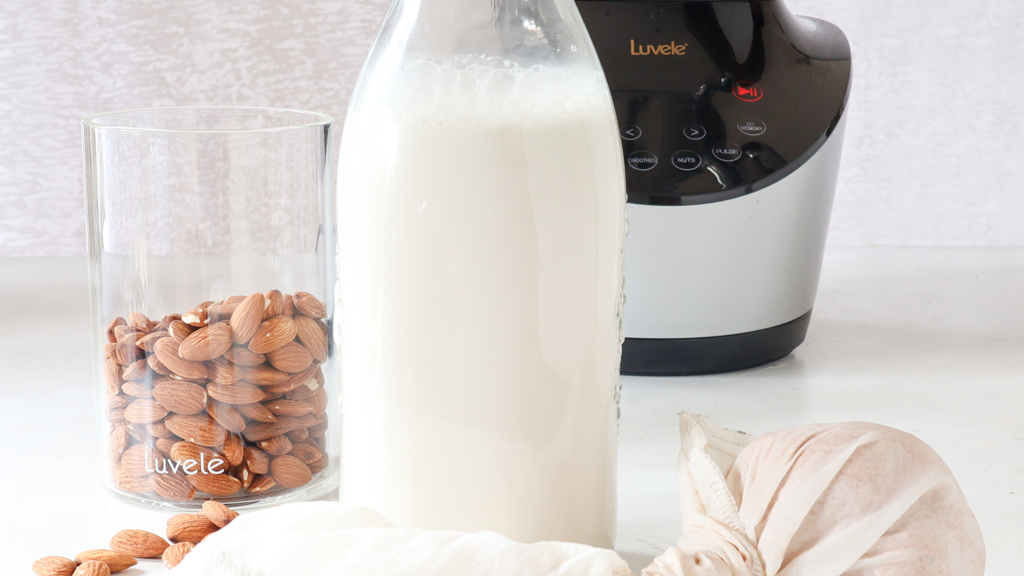Your Cart is Empty
Add description, images, menus and links to your mega menu
A column with no settings can be used as a spacer
Link to your collections, sales and even external links
Add up to five columns
Add description, images, menus and links to your mega menu
A column with no settings can be used as a spacer
Link to your collections, sales and even external links
Add up to five columns

How to make delicious almond milk at home
Barb Hodgens
Barb Hodgens loves to cook with alternative, healthy whole food ingredients, with a focus on gut health. Barb has overcome her own gut health issues through healthy eating. Share your ideas, comments and photos at the end of this post :)

Raw, creamy and delicious!
Making nut milk might sound tricky, but it’s actually incredibly simple. With the Luvele Vibe Blender in your kitchen, the hands-on time is just about 10 minutes – even less once you get the hang of it. Our recipe is paleo-friendly and vegan, and because the nuts remain raw using our blending method, you end up with a plant-based milk full of live enzymatic goodness.
WHY MAKE YOUR OWN?
If you’ve ever tasted homemade nut milk, you’ll know that nothing compares. Store-bought almond milk might be convenient, but nutritionally it doesn’t measure up – it’s often stripped of nutrients and filled with additives and preservatives.
With homemade nut milk, you’re in control – from the freshness of the nuts to the texture and sweetness. Plus, once you’ve mastered the basics, we’ve included three delicious flavour variations to keep things interesting.

UNIQUE VIBE BLENDER TEMPERATURE CONTROL
The Luvele Vibe Blender System features a unique temperature control function that lets you monitor the temperature of ingredients as they blend. High-speed blenders can heat up fast, so this feature is especially handy when working with raw ingredients that shouldn’t exceed 42°C / 107°F, the point at which nutrients begin to degrade.
WHICH NUTS ARE BEST?
Nut milk can be made from any nut you like – experiment to find your favourite! I usually stick to almonds because they’re easy to find, affordable even when organic, and naturally rich in prebiotic fibre – great food for your good gut bacteria.
Always start with raw nuts – organic and unprocessed is best. Toasted nuts may taste great, but the heat destroys some nutrients and prebiotic potential. I also recommend skin-on nuts rather than blanched. The less processed and more natural, the better. If you can find locally grown nuts, even better!
ACTIVATE THE NUTS
Soaking and activating raw nuts might seem like an extra step, but it’s absolutely worth it. Raw nuts contain natural enzyme inhibitors that make them hard to digest and can cause discomfort in sensitive stomachs. Soaking them in water with a little salt helps break down those inhibitors, making the nuts gentler on your gut and allowing your body to absorb their nutrients more easily.
Activated nuts also taste better and blend more smoothly, producing a richer, creamier milk. It’s a small effort with big rewards for both flavour and nutrition.

TO SIEVE OR NOT TO SIEVE
Straining nut milk through a cloth bag is optional. Keeping the skin fibre and pulp gives you a thicker, more nutrient-dense milk that’s full of prebiotic goodness. It’s all about texture preference – pulp left in the milk creates a hearty, slightly grainy drink, while straining produces a silky-smooth result.
If you mainly use nut milk in smoothies, skip the straining step and let your gut microbes enjoy all that extra fibre. If you prefer a smoother finish, a nut milk bag makes straining easy. A piece of muslin cloth works too, though it can be a bit messier.

How to make delicious almond milk at home
Luvele
Rated 5.0 stars by 1 users
Making nut milk sounds tricky but in fact it’s incredibly simple. Our recipe is paleo-friendly and vegan, and if you follow our blending method the nuts remain raw so that you end up with a plant-based milk teeming with live enzymatic goodness.
Ingredients
- 1 ½ cups of raw almonds
- 1 teaspoon of salt (for soaking)
- Water for soaking
- 2 tablespoons of raw honey or maple syrup
- 1 teaspoon of vanilla
- 4 cups of chilled water (for milk)
2 – 4 medjool dates (pips removed)
Pinch of salt2 – 3 tablespoons of cacao powder
1 teaspoon ground cinnamon
BASE RECIPE
FOR CARAMEL NUT MILK - ADD
FOR CHOCOLATE NUT MILK - ADD
FOR CINNAMON NUT MILK – ADD
Directions
- Pour the almonds into a large ceramic bowl, add 1 teaspoon of salt and fill with water. Cover the soaking nuts with a clean tea towel and leave to sit for 8 hours or overnight.
- Pour the soaked nuts into a sieve and thoroughly rinse with running water.
- Pour the activated nuts into the Vibe blender jug. Add 2 cups of cold water and blend on 'nut mode' for 60 seconds or until the nuts are a creamy paste.
- Add the vanilla, sweetener and 1 cup of cold water. Blend for up to 60 seconds, watching the temperature to ensure the milk does not heat above 42 ºC (107 ºF).
- The almonds will now be super thick and creamy. Add the final cup of water and stir with a spatula to incorporate. No further blending is necessary.
- For a smooth milk run the blended nuts through a nut bag to remove the pulp. This step takes a bit of practice and can be messy.
- Twist and squeeze the bag until all the moisture is removed and only dry pulp remains.
- Pour the nut milk into a glass jar and store in the fridge and consume within 4 days.
Recipe Video


PIN THIS RECIPE


How to make delicious almond milk at home

Raw, creamy and delicious!
Making nut milk might sound tricky, but it’s actually incredibly simple. With the Luvele Vibe Blender in your kitchen, the hands-on time is just about 10 minutes – even less once you get the hang of it. Our recipe is paleo-friendly and vegan, and because the nuts remain raw using our blending method, you end up with a plant-based milk full of live enzymatic goodness.
WHY MAKE YOUR OWN?
If you’ve ever tasted homemade nut milk, you’ll know that nothing compares. Store-bought almond milk might be convenient, but nutritionally it doesn’t measure up – it’s often stripped of nutrients and filled with additives and preservatives.
With homemade nut milk, you’re in control – from the freshness of the nuts to the texture and sweetness. Plus, once you’ve mastered the basics, we’ve included three delicious flavour variations to keep things interesting.

UNIQUE VIBE BLENDER TEMPERATURE CONTROL
The Luvele Vibe Blender System features a unique temperature control function that lets you monitor the temperature of ingredients as they blend. High-speed blenders can heat up fast, so this feature is especially handy when working with raw ingredients that shouldn’t exceed 42°C / 107°F, the point at which nutrients begin to degrade.
WHICH NUTS ARE BEST?
Nut milk can be made from any nut you like – experiment to find your favourite! I usually stick to almonds because they’re easy to find, affordable even when organic, and naturally rich in prebiotic fibre – great food for your good gut bacteria.
Always start with raw nuts – organic and unprocessed is best. Toasted nuts may taste great, but the heat destroys some nutrients and prebiotic potential. I also recommend skin-on nuts rather than blanched. The less processed and more natural, the better. If you can find locally grown nuts, even better!
ACTIVATE THE NUTS
Soaking and activating raw nuts might seem like an extra step, but it’s absolutely worth it. Raw nuts contain natural enzyme inhibitors that make them hard to digest and can cause discomfort in sensitive stomachs. Soaking them in water with a little salt helps break down those inhibitors, making the nuts gentler on your gut and allowing your body to absorb their nutrients more easily.
Activated nuts also taste better and blend more smoothly, producing a richer, creamier milk. It’s a small effort with big rewards for both flavour and nutrition.

TO SIEVE OR NOT TO SIEVE
Straining nut milk through a cloth bag is optional. Keeping the skin fibre and pulp gives you a thicker, more nutrient-dense milk that’s full of prebiotic goodness. It’s all about texture preference – pulp left in the milk creates a hearty, slightly grainy drink, while straining produces a silky-smooth result.
If you mainly use nut milk in smoothies, skip the straining step and let your gut microbes enjoy all that extra fibre. If you prefer a smoother finish, a nut milk bag makes straining easy. A piece of muslin cloth works too, though it can be a bit messier.
:recipekit:


PIN THIS RECIPE


Subscribe
Sign up to get weekly healthy recipes & information on new product releases.


